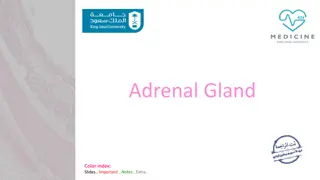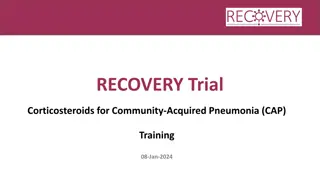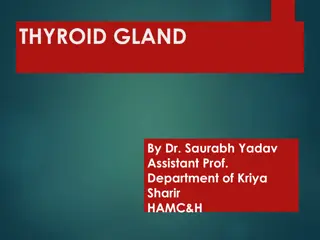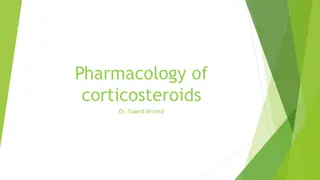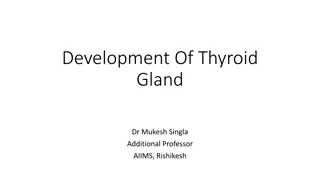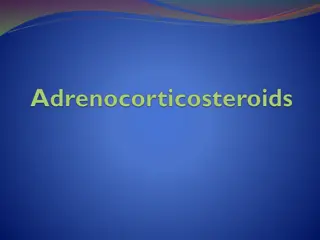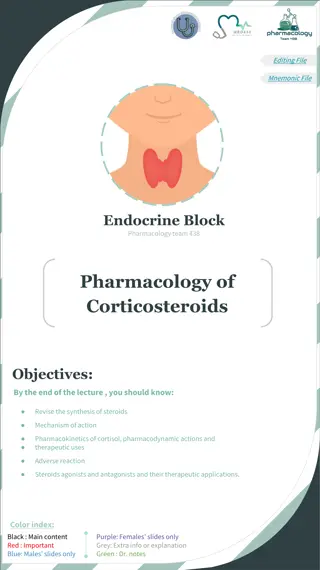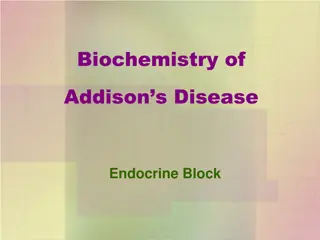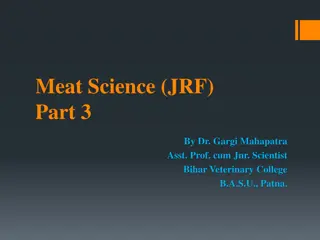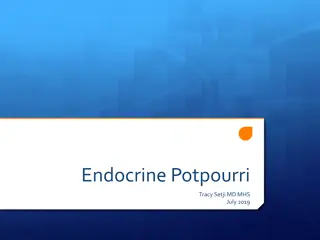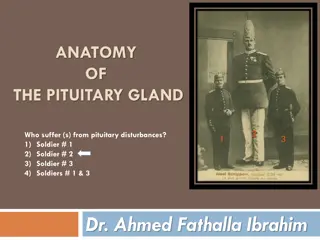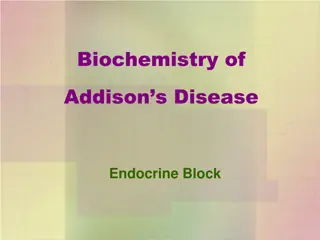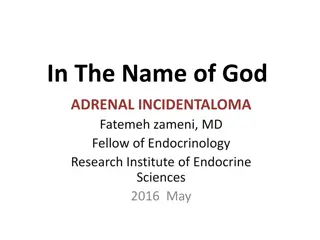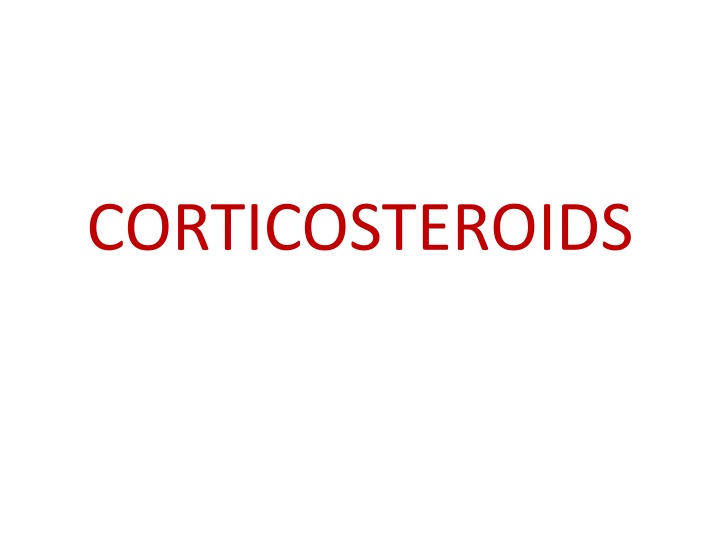
Understanding Corticosteroids and Adrenal Gland Functions
Corticosteroids play vital roles in hormone regulation, with glucocorticoids and mineralocorticoids impacting metabolic and electrolyte balance. These hormones are produced in different zones of the adrenal cortex, influencing various physiological processes including salt and water metabolism. Cholesterol serves as a precursor for steroid synthesis, highlighting the intricate pathways involved in hormone production.
Download Presentation

Please find below an Image/Link to download the presentation.
The content on the website is provided AS IS for your information and personal use only. It may not be sold, licensed, or shared on other websites without obtaining consent from the author. If you encounter any issues during the download, it is possible that the publisher has removed the file from their server.
You are allowed to download the files provided on this website for personal or commercial use, subject to the condition that they are used lawfully. All files are the property of their respective owners.
The content on the website is provided AS IS for your information and personal use only. It may not be sold, licensed, or shared on other websites without obtaining consent from the author.
E N D
Presentation Transcript
Corticosteroids differes in their amount of inherent metabolic (glucocorticoid) and electrolyte regulating (mineralocorticoid) activity.
The actions of these hormones extend to almost every cell in the body.
In humans, hydrocortisone (cortisol) is the main glucocoticoidoid, and aldosterone is the main mineralocorticoid.
The mammalian adrenal cortex is divided into three concentric zones: the zona glomerulosa, zona fasciculata, and zona reticularis.
The zona glomerulosa produces hormones, such as aldosterone, responsible for regulating salt and water metabolism;
The zona fasciculata produces glucocorticoids; and the zona reticularis produces adrenal androgens.
The adrenal gland synthesizes steroids from cholesterol.
Adrenal cortex is also capable of producing and secreting such steroid intermediates as progesterone, androgens, and estrogens.
Cholesterol is transported into the mitochondria of steroidogenic tissue, where side chain cleavage is carried out.
The rate-limiting step in steroid biosynthesis is the conversion of cholesterol to pregnenolone.
The biosynthetic pathway next branches into two separate routes. One route passes through progesterone and corticosterone to aldosterone,
And the other proceeds from 17-hydroxyprogesterone and 1-deoxycortisol to yield cortisol.
11--hydroxylation is essential for glucocorticoid and mineralocorticoid activity of a steroid.
STEROID TRANSPORT IN BLOOD Glucocorticoids are reversibly bound to a specific -globulin known as transcortin or corticosteroid-binding globulin.
The binding is not limited to corticoids. Progesterone and the synthetic glucocorticoid prednisone also can bind to this macromolecule.
STEROID METABOLISM Most of the cortisol circulating in the blood is metabolized before its excretion.
The first step in metabolism is reduction of double bonds and introduction of a hydroxyl group in the a ring ;
The second step in the metabolism of cortisol is a glucuronic acid or sulfate conjugation to form more soluble derivatives.
ACTIONS OF THE CORTICOSTEROIDS In normal physiological concentrations, they are essential for homeostasis, for coping with stress, and for the maintenance of life.
CARBOHYDRATE, PROTEIN, AND FAT METABOLISM The glucocorticoids increase blood glucose and liver glycogen levels by stimulating gluconeogenesis.
The source of this is protein and the protein catabolic actions of the glucocorticoids result in a negative nitrogen balance.
The inhibition of protein synthesis by glucocorticoids brings about a transfer of amino acids from muscle and bone to liver, where amino acids are converted to glucose.
Glucocorticoids also stimulate the catabolism of lipids in adipose tissue and enhance the actions of other lipolytic agents.
This results in an increase in plasma free fatty acids and an enhanced tendency to ketosis.
ELECTROLYTE AND WATER METABOLISM Another major function of the adrenal cortex is the regulation of water and electrolyte metabolism.
The principal mineralocorticoid, aldosterone, can increase the rate of sodium reabsorption and potassium excretion severalfold.
CARDIOVASCULAR FUNCTION Corticosteroids appear to play an important role in the regulation of blood pressure by modulating vascular smooth muscle tone, by having a direct action on the heart, and through stimulating renal mineralocorticoid and glucocorticoid receptors.
IMMUNE AND DEFENSE MECHANISMS The inhibitory effects of glucocorticoids on various aspects of the inflammatory and immunological responses constitute the basis for their therapeutic efficacy.
All steps of the inflammatory process are blocked. Both the early components (edema, fibrin deposition, neutrophil migration, and phagocytosis) and late components (collagen synthesis and deposition) may be retarded.
Glucocorticoids promote apoptosis and reduce survival, differentiation, and proliferation of a variety of inflammatory cells.
During stress, crf is released into the pituitary portal system to stimulate corticotrophin release.
Activation of the hypothalamic pituitary system also accounts for the diurnal, or circadian, nature of cortisol secretion; plasma cortisol concentrations reach a maximum between 6 and 8 a.M. And then slowly decrease through the afternoon and evening.
Corticosteroids also affect adrenomedullary function by increasing epinephrine production.
Finally, steroids can exert suppressive actions on certain endocrine systems. Glucocorticoids inhibit thyroid stimulating hormone pulsatility by depressing thyrotropin-releasing hormone secretion at the hypothalamic level.
Glucocorticoids are inhibitors of linear growth and skeletal maturation in humans.
The anticalcemic effect of the glucocorticoids, which is associated with an amplification of the actions of parathyroid hormone, also may retard bone growth.
The inhibitory action of high levels of glucocorticoids on reproductive function is probably because of attenuation of luteinizing hormone secretion and direct action on the reproductive organs.
ADVERSE EFFECTS When administered in pharmacological doses for long periods, steroids generally produce serious toxic effects that are extensions of their pharmacological actions.
No route or preparation is free from the diverse side effects. Points to be considered when their prolonged use is contemplated.
Treatment with steroids is generally palliative rather than curative, and only in a very few diseases, such as leukemia and nephrotic syndrome, do corticosteroids alter prognosis.
The patients age can be an important factor, since such adverse effects as hypertension are more apt to occur in old and infirm individuals, especially in those with underlying cardiovascular disease.
Glucocorticoids should be used with caution during pregnancy.
Once steroid therapy is decided upon, the lowest possible dose that can provide the desired therapeutic effect should be employed.
OSTEOPOROSIS The most damaging and therapeutically limiting adverse effect of long-term glucocorticoid therapy is impairment of bone formation.
By enhancing bone resorption and decreasing bone formation, glucocorticoids decrease bone mass and increase the risk of fractures.
INFECTIONS Steroids can alter host parasite interactions, suppress fever, decrease inflammation, and change the usual character of the symptoms produced by most infectious organisms.
There is a heightened susceptibility to serious bacterial, viral, and fungal infections.
EFFECTS ON GI MUCOSA It is now realized that ulcerogenic effect is principally observed in patients who have received concomitant nonsteroidal antiinflammatory treatment.
HYPERGLYCEMIC ACTION In about one-fourth to one-third of the patients receiving prolonged steroid therapy, the hyperglycemic effectsof glucocorticoids lead to decreased glucose tolerance, decreased responsiveness to insulin, and even glycosuria.


